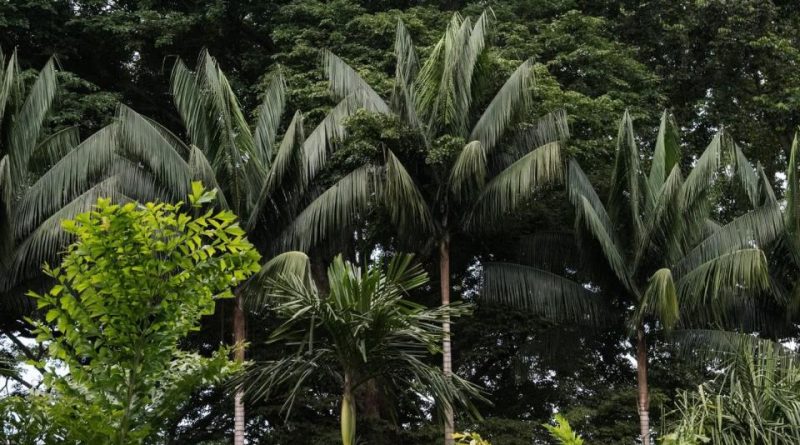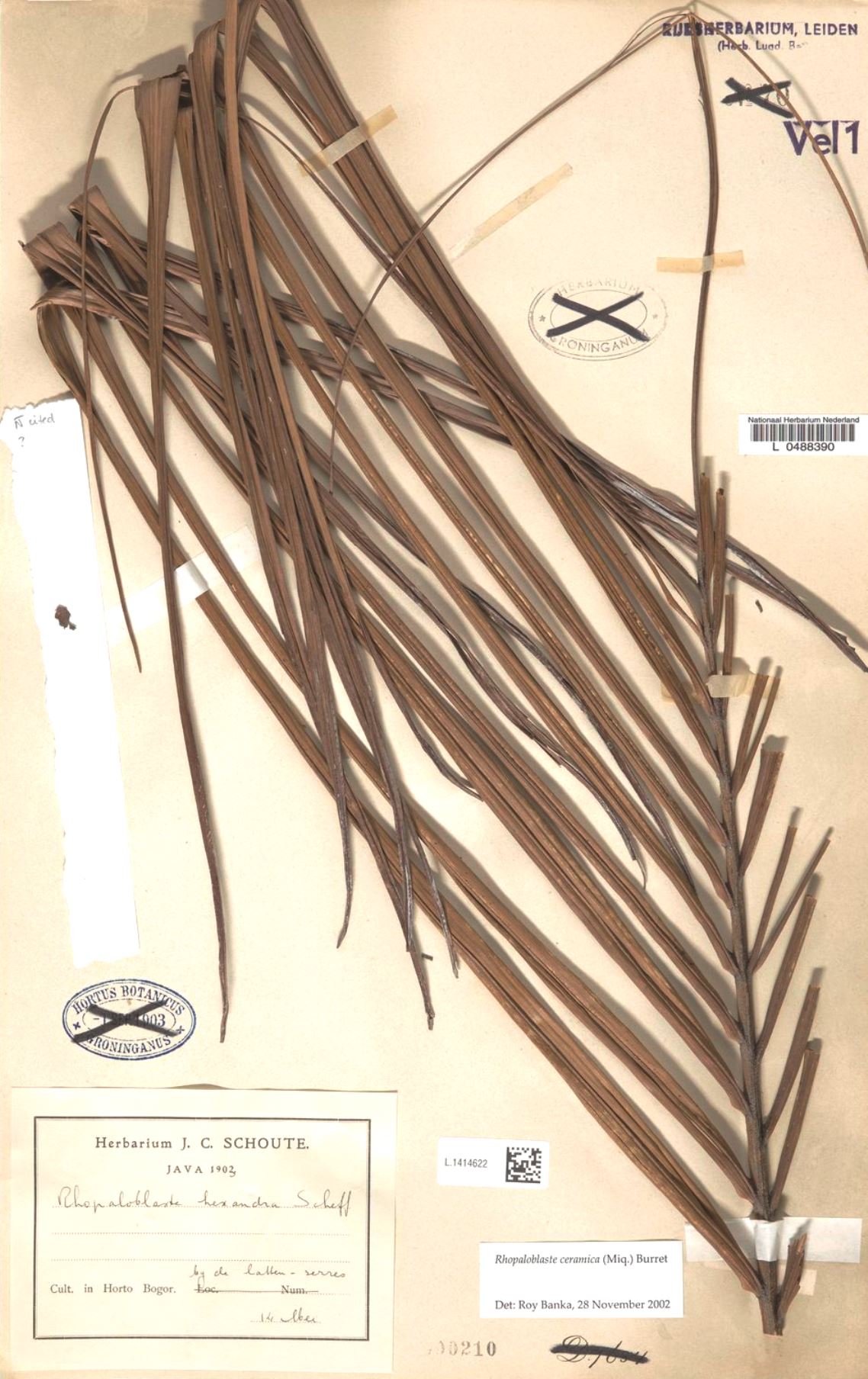Rhopaloblaste ceramica
Rhopaloblaste ceramica
The Majestic Palm or Ceramic palm (Rhopaloblaste ceramica (Miq.) Burret, 1928) is an arboreal species belonging to the Arecaceae family.
Systematic –
From a systematic point of view it belongs to:
Eukaryota domain,
Kingdom Plantae,
Division Magnoliophyta,
Class Liliopsida,
Subclass Arecidae,
Order Arecales,
Arecaceae family,
Subfamily Arecoideae,
Tribe Areceae,
Subtribe Iguanurinae,
Genus Rhopaloblaste,
Species R. ceramic.
The term is basionym:
– Bentinckia ceramica Miq..
The terms are synonymous:
– Cyrtostachys ceramica (Miq.) H.Wendl.;
– Rhopaloblaste dyscrita H.E.Moore;
– Rhopaloblaste hexandra Scheff.;
– Rhopaloblaste micrantha Burret.
Etymology –
The term Rhopaloblaste derives from the Greek “ῥόπᾰλον” rhópalon, i.e. club, club and “βλαστός”, blastós, i.e. bud, embryo, in reference to the shape of the embryos.
The specific ceramic epithet refers to the origin from the island of Ceram, Moluccas, where this palm was discovered.
Geographic Distribution and Habitat –
The Rhopaloblaste ceramica is a palm native to the Moluccas and northwestern region of New Guinea. Specifically, we find it from Halmahera and Buru in the Moluccas up to Ceram, then in mainland New Guinea. In Papua New Guinea it is known with certainty only from the provinces of Sandaun and East Sepik in the north-western part of the country.
Its habitat is from well-drained plains to lower montane primary rainforests. In secondary rainforests it is found both in old gardens and black, deep, loose, porous volcanic soils but also on alluvial plains in deep clay soils, from 35 to 900 m above sea level.
Description –
The Rhopaloblaste ceramica is a dioecious palm, with a single crown and with up to 15 – 17 leaves in the crown.
The stem is up to 35 m tall, with a diameter of 15 – 29 (35) cm, with a slightly rough surface, presence of prominent brownish gray leaf scars and internodes 12 – 14 cm basally, decreasing to 1 cm distally.
The leaf rachis is 3 to 4 m long and is covered, especially in the lower part, with abundant dark brown bloom. The pinnules are regularly arranged on the rachis, from 110 to 120 on each side, about 3 cm apart, up to 115 cm long and 2.5 cm wide. These have a linear shape with a bifid apex and all hang downwards, on the same plane. The upper plate is dark green, with small brown scales on the central vein, while the lower one is dull green, with diffuse brown tomentum.
The leaves are carried by petioles up to 3.5 cm long which end in a whitish sheath that wraps the trunk, up to 1.5 m long and up to 40 cm wide, partially covered by brown tomentum.
The large inflorescence is initially enclosed by a rough deciduous gray spathe that emerges at the rings on the stem, under the leaf sheaths. After opening, the inflorescence develops up to approximately 130 cm in length and up to 150 cm in width, on a robust peduncle 8-10 cm long and 10 cm wide.
The inflorescence has a complex shape, branched on 3 orders, with robust rachilles, oriented in different directions, up to 75 cm long and up to 7 cm wide. The flowers are sunk in small wells, arranged in triads formed by one female and two male flowers.
The fruit is 3.5 cm long and 1.8 cm wide, ellipsoidal and asymmetrical in shape, yellow when immature and then red when ripe, with a fibrous mesocarp.
Inside there is the seed which is 3 cm long and 1.6 cm wide, dark brown in colour.
Cultivation –
The Rhopaloblaste ceramica is the largest of all the species of the genus and can be distinguished from the better known Rhopaloblaste augusta by its large asymmetrical fruits and the inflorescence branched on three orders with very robust rachilles.
This palm is considered one of the most beautiful due to the elegant shape of the large crown of leaves hanging on the tall and thin trunk. However, it is not yet widespread in parks and gardens outside of South East Asia, despite it not presenting particular cultivation difficulties.
It is an easy and fast growing palm for the tropics and very popular in cultivation in South Asia.
This palm, however, can only be grown in hot tropical and subtropical climates as it is unable to withstand temperatures below 10 °C for long periods. For cultivation, especially young specimens need shady positions, sheltered from the winds; once grown they can vegetate very well in a sunny position.
From a pedological point of view, it is not a particularly demanding palm but prefers a substrate that is kept humid and well-drained.
The plant reproduces by seed, kept in water for 5 days and then buried in a sandy, humid, well-drained substrate, at a constant temperature above 26 °C.
Customs and Traditions –
The Rhopaloblaste ceramica was the first species of the genus Rhopaloblaste to be described, based on material collected in 1860 by Teijsmann and de Vriese at Ceram in the Moluccas. Miquel originally placed it in the genus Bentinckia as B. ceramic Miq. Ten years later it was transferred to the genus Cyrtostachys (C. ceramic (Miq.) H. Wendl.). However, in 1928 it was definitively transferred to the genus Rhopaloblaste.
This palm is known by various common names including: Majestic Palm and Ceramic palm (English), Ahad, Henahena, Ogulubenge (Indonesian).
This palm is used, especially by indigenous populations for various purposes, among which it is reported that the vegetative apex is edible; the stem is used by the natives to make arrowheads and to make the floorboards of the houses.
Only occasionally is it cultivated for ornamental use, being widespread for this purpose only in southern Asia.
Preparation Method –
The Rhopaloblaste ceramica is a plant used for food purposes but, in any case, limitedly by the natives in the area of origin of the Molucca islands and the north-western region of New Guinea, in an area that extends from lowland woods to primary mountain rainforests, from 35 to 900 m above sea level
In these areas it is used both for food purposes, taking the tip of the shoot which is edible; furthermore the wood is used to make arrowheads and floorboards for houses. Only occasionally is it cultivated in these areas as an ornamental plant.
Guido Bissanti
Sources
– Acta Plantarum – Flora of the Italian Regions.
– Wikipedia, the free encyclopedia.
– GBIF, the Global Biodiversity Information Facility.
– Useful Tropical Plants Database.
– Conti F., Abbate G., Alessandrini A., Blasi C. (ed.), 2005. An annotated checklist of the Italian vascular flora, Palombi Editore.
– Pignatti S., 1982. Flora d’Italia, Edagricole, Bologna.
– Treben M., 2000. Health from the Lord’s Pharmacy, Advice and experiences with medicinal herbs, Ennsthaler Editore.
Photo source:
– https://www.nparks.gov.sg/florafaunaweb/flora/3/2/3248
– https://medialib.naturalis.nl/file/id/L.1414622/format/large
Attention: Pharmaceutical applications and food uses are indicated for informational purposes only, they do not represent in any way a medical prescription; we therefore decline any responsibility for their use for healing, aesthetic or food purposes.


